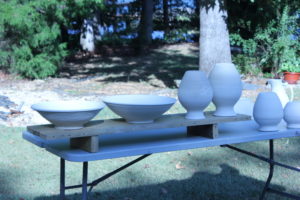Normally, you will want to let let a piece dry at a slow natural pace. this prevents cracking and warping of a piece by letting the moisture travel throughout the piece to balance humidity as water evaporates from areas with more exposed surface area. however, time constraints will occasionally force the more rapid drying of a piece.
The traditional way to do this is to let a piece dry in the sun. the heat will dry a piece much faster, but this will also bring up some additional concerns that must be addressed to protect the piece being dried. first, the sun is directional, meaning that it will dry areas it illuminates faster than areas in the shade.A piece might need to be rotated to counteract the effects of this uneven force on the pot in question.
Depending on the nature of a piece, a different clay may be needed to accommodate the stresses that rapid drying presents. It is up to the potter to know if the new clay body is appropriate for the glaze and the function of a piece. One option is to have a similar body of paper clay ready for quick firings. The fibers in paper will function is a conduit for moisture for travel throughout the piece, as well as fortify it against the stress caused by rapid drying.
One last thing to note is the slit in my platform in the picture above. this gives the moisture in my piece an easy route to escape, moisture which can potentially impede the drying process and introduce stress as an inside is wetter than an outside.


